What the ... ?
It’s exciting, y’all: The temperature at Back Swamp, Florence County, South Carolina, dipped below 50F this morning! Okay, folks living in the Twin Cities (especially you, Jeff) need not remind me that they’d gotten their first snow on October 14 (the earliest since 2009). Just let me have my 50F, please. I’m not excited about snow and ice and all that's associated with winter; after all, I’m a tropical boy. But, after the brutal summer heat and the storms we had this year (knock on wood—there is still a week to the end of the hurricane season), I’m happy to have a cool reprieve and see my wife and her dog enjoy the weather.
The dropping temperature also reminds many creatures of their need to hustle up an overwintering site. Many insects have been on the move since late September. I’m happy to send off the mosquitoes, which had been breeding, carousing and getting drunk on my blood in the stagnant pools created by Hurricane Florence and refilled by the remnants of Hurricane Michael. I’ve also gotten several requests to identify caterpillars that were wandering around people’s yards.
Here are the few, the proud and the wonderful. Who do you think they are?
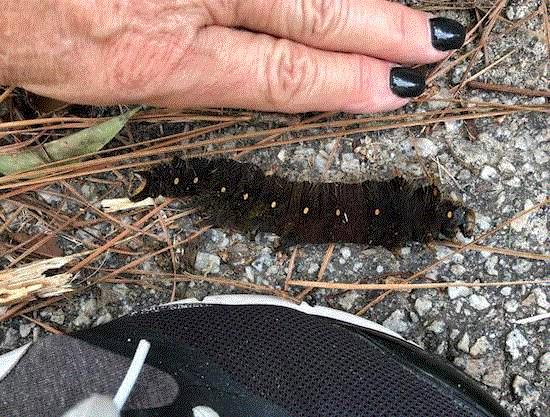
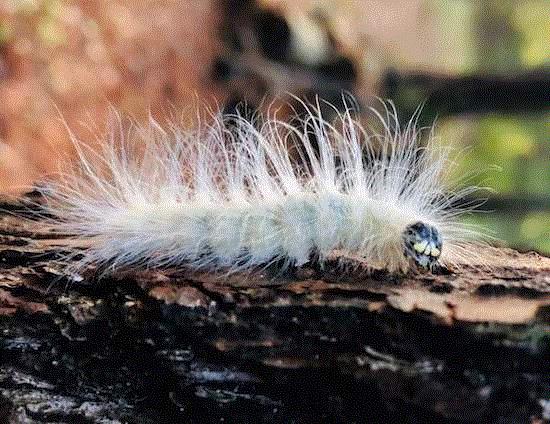
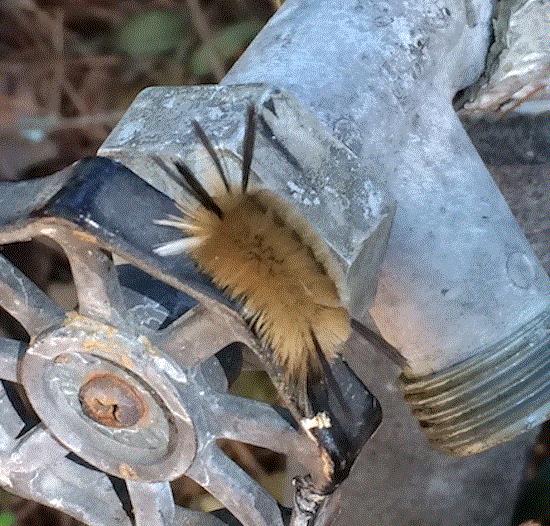
What are the names of these caterpillars? [Photos by Michaele Duke, Kingstree News (top and middle); JC Chong (bottom).]
JC learned a lesson about erwinia
I might have mentioned in the past that I’m part of a research team headed by Cristi Palmer of IR4, and funded by USDA Specialty Crop Research Initiative, to investigate how to best protect pollinators in floriculture. A major objective of the project is to study how systemic insecticide residues degrade in nectar and pollen of selected plant species. I’m using Kniphofia uvaria, or red hot poker, as one of the nectar plants.
I had about 140 of them growing beautifully since last year. Yes, “had” is a key word. They survived the spring snowstorm of 2018 (although the hoop house they were in didn’t). They were looking great until many of them declined and died this summer. My helpers thought the plants were just getting too hot while growing in black pots under full sun during one of our hottest summers. Their response? More water. The result? More dead plants. That cycle sounds familiar, right?
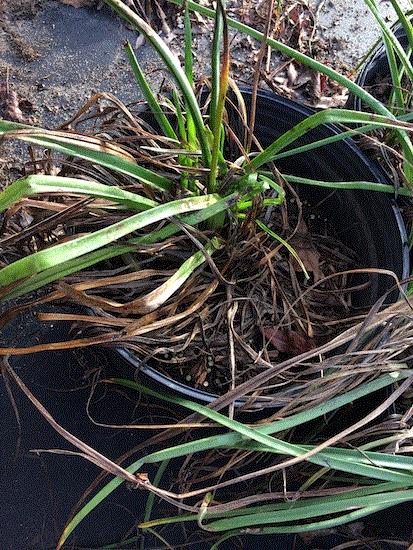
I took my hands off the keyboard and headed to the nursery plot as soon as I was told that the red hot pokers weren’t looking so hot. I pulled some of the dying plants out of the pots. Seeing that they were rotten at the crown, I sniffed and my heart sank (some of you also know that feeling). That smelled bacterial, I thought. I took some samples to our Plant and Pest Diagnosis Clinic for diagnosis, and sure enough, it was erwinia, or soft rot.
Many of you are familiar with erwinia, and the characteristic fishy smell that’s released when the bacteria break down plant tissues. Contaminated medium, soil, tools, water and cuttings can all be sources of erwinia. Our infection might have originated from untreated irrigation water drawn from a retention pond, where runoff from roads and agricultural fields on my experiment station was collected. A study by David Norman of University of Florida reported that water drawn from nursery retention ponds contained high numbers of bacterial cells, and that 99% of bacterial cells found in this study were pathogenic. High fertility (fertilizers are essentially mineral salts that can stress plant roots), high temperature and a constantly wet environment allowed erwinia to spread and reach an outbreak level in my nursery in a very short period of time. By the end of August, I had lost two-thirds of my red hot pokers.
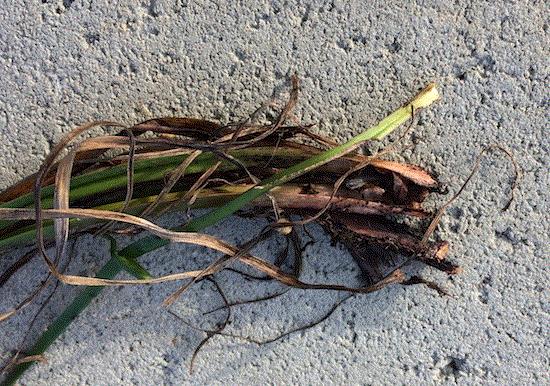
I dumped all the dead and dying plants (pots, medium and all) pronto. I put 35% shade over, and elevated the surviving plants. The shade not only lowered the medium temperature, it also reduced the need to irrigate. I also treated the surviving plants with fungicides. I couldn't do anything with the irrigation water, so I had to maintain a good fungicide program.
There is no pesticide that can completely rid plants of erwinia. Fungicides and bactericides containing copper can slow the spread and prevent infection, but cannot cure an infection. Several copper products are available, including copper hydroxide (Champ, CUPRO, Kocide and Nu-COP), copper octanoate (Camelot O), copper sulfate pentahydrate (Phyton), tribasic copper sulfate (Cuproxat), and a mixture of copper hydroxide and mancozeb (Junction). Check the fungicide labels for use sites and application instructions and restrictions. I was reluctant to use antibiotics because I was wary of resistance development.
I’m kicking myself for letting this happen. All the “shoulda, coulda, woulda” mean nothing now. I’m glad it wasn’t a total loss. I still got some good-looking ones I can split this fall, and care for next year. I learned my lesson, and I’m wiser for next time.

Pests you may encounter while finishing poinsettia
How’s your poinsettia crop finishing up? I haven't had many chances to keep up with poinsettia production and trends because many growers in my area have stopped growing this crop. If you let me, I’ll be happy to knock on your door to learn about the latest in poinsettia production and pest management.
Hopefully, your poinsettia crop is pest-free. Usually, insect pests are rare at finishing if you’ve done your due diligence during production. There are many excellent chemical and biological options for managing insect pests on poinsettias during production.
Whiteflies and thrips are the most common insect pests during finishing. You might have to use insecticides to knock down the population if you are only weeks away from shipping, but you still have a few whiteflies and thrips. If you are two or more weeks from shipping, medium drench with Flagship (thiamethoxam), Mainspring (cyantraniliprole) and Safari (dinotefuran) may still have a chance to work against whiteflies. But if you are less than two weeks from shipping, you will have to rely on sprays of Avid (abamectin), Flagship, Judo (spiromesifen), Rycar (pyrifluquinazon), Safari, Sanmite (pyridaben) and TriStar (acetamiprid) to reduce whitefly population. For thrips, your options are Avid, Conserve, Flagship, Mainspring, Safari and TriStar.
Pythium and rhizoctonia can be a big problem during production. They can also catch up with you if you let your guard down during the finishing stage. Keep up with your moisture and fungicide management programs for pythium and rhizoctonia until the plants are out of the door. A bigger problem during finishing stage is botrytis. Maintaining good air movement and reducing humidity go a long way in minimizing infection. Heating and venting simultaneously is a good way to reduce humidity during finishing; this method may sound like a waste of energy (and hence, money) but it’s totally worth the effort especially during rainy days. Plants should also be protected with fungicides, including Broadform (fluopyram + trifloxystrobin), Decree (fenheximid), Medallion (fludioxonil), Milstop (potassium bicarbonate) and Pageant Intrinsic (pyraclostrobin + boscalid).
One of the most critical factors in deciding which pesticide to use during the finishing stage is bract safety. The insecticides and fungicides mentioned above are considered safe for bracts when applied properly. However, you need to understand that crop safety has not been evaluated for all cultivars. Just to be on the safe side, you should try a product on a few plants and observe for phytotoxicity before you make a broadcast. Also, read the labels carefully to determine if you need to use a lower rate (such as Milstop) or avoid mixing in an organosilicone surfactant (such as Pageant Intrinsic). It’s important to rotate among insecticides and fungicides of different modes of action to avoid the development of pesticide resistance.
By the way, did you miss the GrowerTalks webinar on October 16, “New research, new innovation in botrytis management?” Janna Beckerman of Purdue University and Aaron Palmateer of Bayer teamed up to talk about botrystis and the new fungicide Broadform. You can view the archived webinar by clicking here.

Answers to the "What the ... ?"
I will now reveal the identities of the wandering caterpillars.
The big, black one is a caterpillar of the imperial moth, Eacles imperialis. This is one of the largest, and perhaps the most widely distributed saturniid moths in the eastern United States. The adults have a wingspan of 3-7 in., and are yellow with reddish brown markings. The appearance of this species varies greatly throughout its range. I’ve seen adults more frequently in the summer in South Carolina. There is a debate on whether the imperial moth has one or two generations per year. Caterpillars feed on many plant species, with oaks and sweetgum being the most preferred in my area. This one was found wandering on the ground; it was likely looking for a place to pupate in the soil. Donald Hall wrote a wonderful factsheet on this species with lots of great pictures and descriptions.
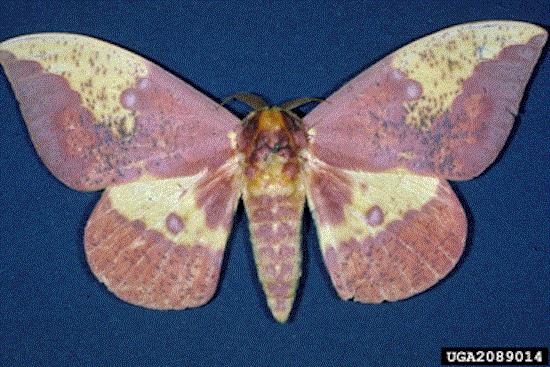
Adult imperial moth. (Photo by Lacy Hyche, Auburn University; Bugwood.org)
The second, fuzzier one is the laugher moth caterpillar, Charadra deridens (a.k.a. the marbled tuffet moth). I didn't identify this one. The credit belongs to my good friend and colleague Sarah White of Clemson University, who also forwarded to me the imperial moth picture taken by Michaele. (Thanks for sharing the pictures, Michaele!) Guess why this moth is called the laugher moth? See the yellow patch on its face (which only appears in older caterpillars), which makes the caterpillar look like it’s laughing? Its species epithet, “deridens,” derives from the Latin “deridere” or to deride, mock or laugh at. The adults have a wingspan of 1.5 to 1.9 in.; it’s a bit hard to describe the patterns on the wings except that they are mottled gray with black lines. This species is widely distributed east of the Rockies and in southern Canada. They are common in the summer and caterpillars feed on beeches, birches, elms, maples and oaks.

Adult laugher moth. (Photo by Mark Dreiling; Bugwood.org)
The last one is a very common caterpillar in my neck of the woods—a banded tussock moth, Halysidota tessellaris. This species is also called tessellated halisidota, pale tussock moth or pale tiger moth. I found this one on my spigot, as it had mistaken the spigot as a good place to pupate. Now, my question is, “How in the world am I going to use the spigot without crushing the cocoon?” The cocoons are wrapped in silk and attached to surfaces or in the leaf litter. The species epithet, “tessellaris,” derives from the Latin “tessella” or little square stone, which refers to the checkered wings of adults (the wingspan is 1.6 to 1.8 in.). It’s common from southern Canada south to Texas and central Florida. There is one generation in the North and two generations in the South. The caterpillars feed on a wide variety of deciduous tree species, with oaks seeming to be the most preferred hosts around my house. By the way, you’ll itch for days if you have one of these tussock moth caterpillars fall down your shirt (based on the personal experience of yours truly).
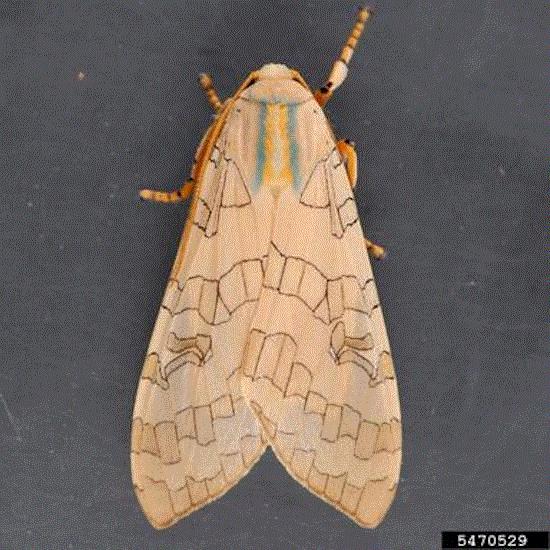
Adult banded tussock moth. (Photo by Mark Dreiling; Bugwood.org)
Metamorphosis does wonders, y’all. I wonder what I’ll turn into when I grow up?






See y'all next time!

JC Chong
Associate Professor of Entomology at Clemson University
This e-mail received by 24,717 subscribers like you!
If you're interested in advertising on PestTalks contact Kim Brown ASAP!